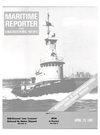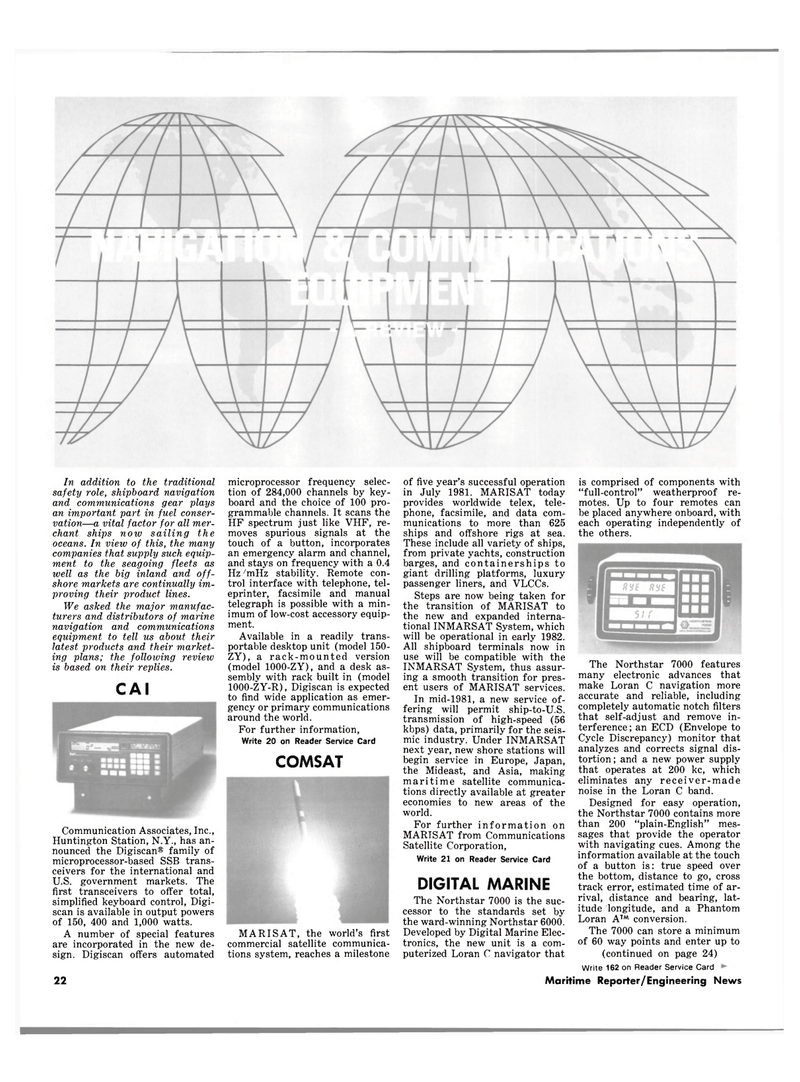
Page 20: of Maritime Reporter Magazine (April 15, 1981)
Read this page in Pdf, Flash or Html5 edition of April 15, 1981 Maritime Reporter Magazine
In addition to the traditional safety role, shipboard navigation and communications gear plays an important part in fuel conser- vation—a vital factor for all mer- chant ships noiv sailing the oceans. In view of this, the many companies that supply such equip- ment to the seagoing fleets as well as the big inland and off- shore markets are continually im- proving their product lines.
We asked the major manufac- turers and distributors of marine navigation and, communications equipment to tell us about their latest products and their market- ing plans; the following revieiv is based on their replies.
C AI
Communication Associates, Inc.,
Huntington Station, N.Y., has an- nounced the Digiscan® family of microprocessor-based SSB trans- ceivers for the international and
U.S. government markets. The first transceivers to offer total, simplified keyboard control, Digi- scan is available in output powers of 150, 400 and 1,000 watts.
A number of special features are incorporated in the new de- sign. Digiscan offers automated 22 microprocessor frequency selec- tion of 284,000 channels by key- board and the choice of 100 pro- grammable channels. It scans the
HF spectrum just like VHF, re- moves spurious signals at the touch of a button, incorporates an emergency alarm and channel, and stays on frequency with a 0.4
Hz/mHz stability. Remote con- trol interface with telephone, tel- eprinter, facsimile and manual telegraph is possible with a min- imum of low-cost accessory equip- ment.
Available in a readily trans- portable desktop unit (model 150-
ZY), a rack-mounted version (model 1000-ZY), and a desk as- sembly with rack built in (model 1000-ZY-R), Digiscan is expected to find wide application as emer- gency or primary communications around the world.
For further information,
Write 20 on Reader Service Card
COMSAT
MARISAT, the world's first commercial satellite communica- tions system, reaches a milestone of five year's successful operation in July 1981. MARISAT today provides worldwide telex, tele- phone, facsimile, and data com- munications to more than 625 ships and offshore rigs at sea.
These include all variety of ships, from private yachts, construction barges, and containerships to giant drilling platforms, luxury passenger liners, and VLCCs.
Steps are now being taken for the transition of MARISAT to the new and expanded interna- tional INMARSAT System, which will be operational in early 1982.
All shipboard terminals now in use will be compatible with the
INMARSAT System, thus assur- ing a smooth transition for pres- ent users of MARISAT services.
In mid-1981, a new service of- fering will permit ship-to-U.S. transmission of high-speed (56 kbps) data, primarily for the seis- mic industry. Under INMARSAT next year, new shore stations will begin service in Europe, Japan, the Mideast, and Asia, making maritime satellite communica- tions directly available at greater economies to new areas of the world.
For further information on
MARISAT from Communications
Satellite Corporation,
Write 21 on Reader Service Card
DIGITAL MARINE
The Northstar 7000 is the suc- cessor to the standards set by the ward-winning Northstar 6000.
Developed by Digital Marine Elec- tronics, the new unit is a com- puterized Loran C navigator that is comprised of components with "full-control" weatherproof re- motes. Up to four remotes can be placed anywhere onboard, with each operating independently of the others.
The Northstar 7000 features many electronic advances that make Loran C navigation more accurate and reliable, including completely automatic notch filters that self-adjust and remove in- terference; an ECD (Envelope to
Cycle Discrepancy) monitor that analyzes and corrects signal dis- tortion ; and a new power supply that operates at 200 kc, which eliminates any receiver-made noise in the Loran C band.
Designed for easy operation, the Northstar 7000 contains more than 200 "plain-English" mes- sages that provide the operator with navigating cues. Among the information available at the touch of a button is: true speed over the bottom, distance to go, cross track error, estimated time of ar- rival, distance and bearing, lat- itude/longitude, and a Phantom
Loran A™ conversion.
The 7000 can store a minimum of 60 way points and enter up to (continued on page 24)
Write 162 on Reader Service Card
Maritime Reporter/Engineering News

 19
19

 21
21
